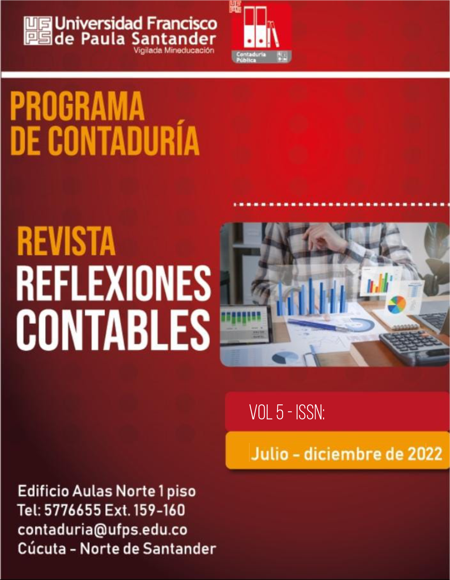Audit of accounts receivable
Auditoría de la cuenta por cobrar
Main Article Content
The purpose of the present study is to analyse the impact of the audit on accounts receivable in the financial statements by conducting a quantitative investigation, in order to obtain information that allows to identify and understand the internal processes of the companies, with descriptive design and thus to collect sufficient information of the accounting management of the accounts receivable and applicable audit procedures, by searching for information in policy documents, databases, journals and books. It is obtained as evidence and is able to identify that the application of the integrated internal control framework COSO 3 allows and contributes to the identification and recognition of shortcomings in the internal control system, which contribute little to the good fulfillment of goals or objectives set by the administration. In turn, audit procedures are defined that allow the verification of bad debtors, at the same time a correct management of credit and collection; determining whether accounts receivable exceed the agreed deadline and their maturity in number of days, if the latter is very high they should be given appropriate accounting treatment such as portfolio impairment; the accounts receivable reflected in the financial statements have a significant impact as they constitute a percentage value of the value of the entity’s total assets, in conclusion accounts receivable influence liquidity capacity; and if these are not managed efficiently they could cause inconvenience in the future which will affect the operational effectiveness that is, the fulfillment of goals and objectives.
Downloads
Article Details
Congreso de la Republica. (2009) Diario Oficial No. 47.409 de 13 de julio de 2009. Tomado de: http://www.secretariasenado.gov.co/senado/basedoc/ley_1314_2009.html
Diana, P. (2017). Auditoría Financiera y contable. Fundación Universitaria del Área Andina. https://digitk.areandina.edu.co/bitstream/handle/areandina/1297/Auditoria%20Financiera%20y%20Contable.pdf?sequence=1&isAllowed=y
Elizalde, L. (2018). Auditoría financiera como proceso para la toma de decisiones gerenciales Revista Observatorio de la Economía Latinoamericana,. Tomado de: https://www.eumed.net/rev/oel/2018/10/auditoria-financiera-decisiones.html
Escalante D., Pedro P. (2014). Auditoría financiera: Una opción de ejercicio profesional independiente para el Contador Público. Actualidad Contable Faces, 17 (28) ,40-55. ISSN: 1316-8533. Disponible en: https://www.redalyc.org/articulo.oa?id=25731098004
Estupiñán, J. (2020). Metodología aplicada en las investigaciones sobre la implementación de las Niif en Colombia. Universidad Libre, Colombia. Recuperado de: http://www.unilibre.edu.co/bogota/pdfs/2020/ponencia-contametria-2020-B4.pdf
Forero, A., Forero, L., & Cerquera, H. 2017. La auditoría financiera y su influencia en el sector empresarial. Revista Facultad de ciencias contables, económicas y administrativas 7 (1) 50-57. Recuperado de: https://editorial.uniamazonia.edu.co/index.php/faccea/article/view/229
Gamboa, J., Hurtado J., Ortiz, A., & Barragán, C. (2017). Propuesta de caso práctico para la enseñanza de la materia de Auditoría Financiera. Revista Publicando, 4(12 (1), 627-641. Recuperado a partir de: https://revistapublicando.org/revista/index.php/crv/article/view/729
García, S. Dueñas, R. & Meza, A. (2017). Una Interpretación estratégica de las NIIF para pymes en Bogotá. Revista Logos Ciencia & Tecnología, 9(1), 141-155. Tomado de: https://doi.org/10.22335/rlct.v9i1.371
Gonzales, P & Sanabria, S. (2020) Gestión de cuentas por cobrar y sus efectos en la liquidez en la facultad de una universidad particular, Lima, periodo 2010-2015. Revista de investigación valor contable, 3(1), 57 - 72. Recuperado de: https://doi.org/10.17162/rivc.v3i1.1232
Huaraca, M. (2021). La auditoría financiera y su incidencia en los estados financieros en la empresa servicios especializados y logísticos en general s.a. Selegsa Ate, lima 2019. [Tesis de pregrado Universidad Peruana de las Américas, Lima, Perú]. Tomado de: http://repositorio.ulasamericas.edu.pe/handle/upa/1396
López, V. & Viasus, A. (2020). Aplicación de las NIIF en Colombia comparado con Uruguay.[Tesis de pregrado, Universidad Jorge Tadeo Lozano]. Recuperado de: http://hdl.handle.net/20.500.12010/16676
Manrique, J. (2019) Introducción a la auditoria. Universidad Católica de los Ángeles Chimbote. http://repositorio.uladech.edu.pe/bitstream/handle/20.500.13032/14790/INTRODUCCION%20A%20LA%20AUDITORIA%20%281%29.pdf?sequence=3&isAllowed=y
Palma, P. (2019). Análisis de la NIIF para pymes: provisiones y contingencias en la Empresa DISTPROLABECUADOR S.A. [Tesis de Pregrado, Instituto Superior Tecnológico Bolivariano de Tecnología]. https://rraae.cedia.edu.ec/Record/ITB_dbd2c0493d6a322366f892963579cbcd
Posso, L., Alegría, L., Moreno, C. (2018). Aplicación de normas internacionales de auditoria en la entidad comercial Distridose S.A.S. [Tesis de Pregrado, Universidad Cooperativa de Colombia]. https://repository.ucc.edu.co/bitstream/20.500.12494/7615/1/2018_aplicacion_nias_distridose.pdf
Sierra, A. (2020). El papel del auditor financiero como agente de cambio en los procesos de gestión de calidad. [Tesis de pregrado, Universidad Militar Nueva Granada] Recuperado de: http://hdl.handle.net/10654/37928







